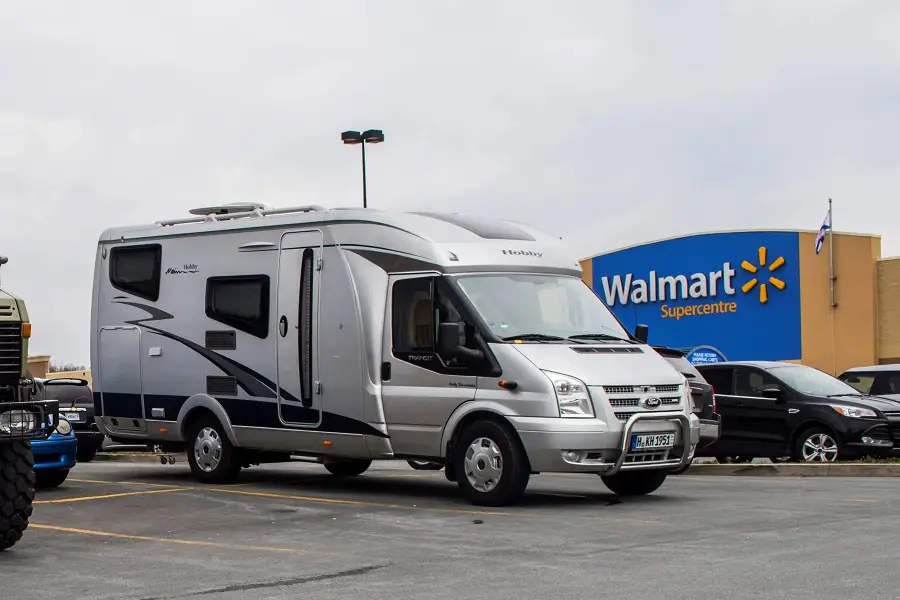Taking on a project as big as building your own campervan means that you’ll be faced with a lot of tough decisions. One of the most important decisions you’ll have to make is what bed design to opt for.
There are already a ton of cool and unique designs out there, but it can be hard to get started. So, we’ve rounded up 11 of the best designs that already exist to help give you some inspiration. Not only are these designs creative, they also provide practical solutions too – especially when it comes to living space and storage!
Whether you’re looking for a fixed bed design or something which provides you with a little more floor space, we’ve got you covered. Some of them are simple, some are more practical, and others are just unique!
In this guide, we’ll give you a vast range of campervan bed ideas so you can figure out which design is right for your needs and layout.
Let’s get started!
Types of Bed Design
Platform Bed
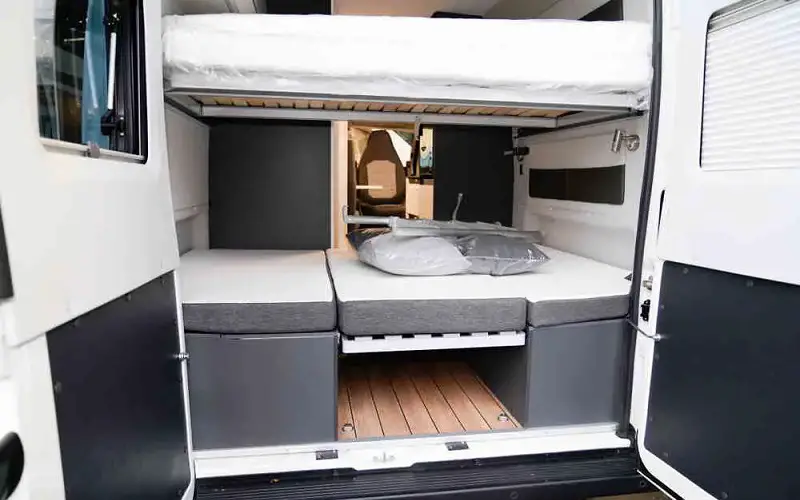
The platform bed is probably the most standard campervan bed solution. It’s a classic design, which is commonly used for van conversions.
Platform beds stay in a fixed position, with one dedicated bed space. One of the reasons as to why it’s so popular is that there is no daily assembly required – you can simply fall into bed each night, without having to set anything up.
Another reason as to why fixed platform beds are frequently used in campervan conversions is because there’s lots of room underneath them for storage. This area is also referred to as the garage. You can use the space to store clothes, water, camping coolers/refrigerators, and even bikes.
However, there is one major drawback to using a static platform bed. That is the fact that it often means that you’re missing out on utilizing the space for a large seating area. This isn’t ideal if you plan on hosting people, or plan on spending a lot of time in your van. With that being said, the bed can always double up as a sofa – just be sure to get some throw pillows to add to the comfort!
Pros:
- Bed is already pre-assembled, so need to set it up each night
- Can create a large storage area underneath
Cons:
- Doesn’t leave any room for a seating area
Convertible Beds
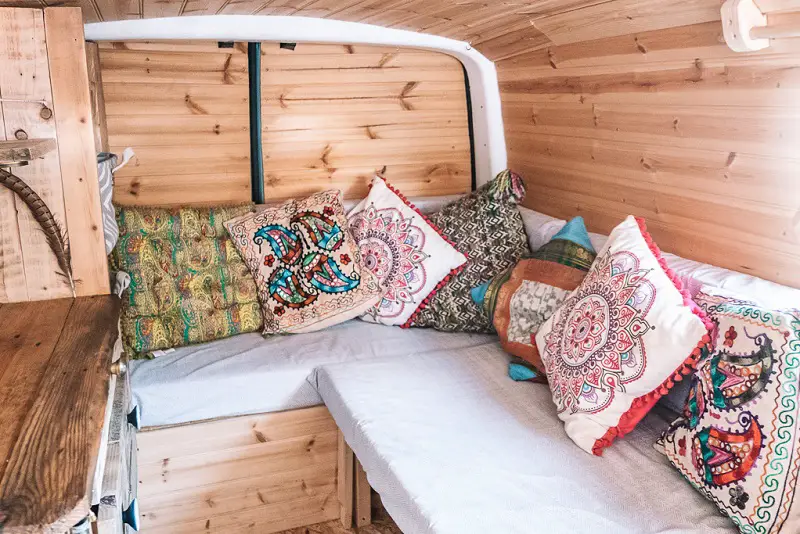
When they’re not in use, convertible beds can be folded up to create room for sofas, dinettes, and equipment storage.
These are convenient bed designs, especially if you have a narrower van, want to host more than two people at once, or you need a workspace.
However, convertible beds take a lot more assembly time than platform beds, and can often be inconvenient if your sleeping schedule differs from your partner’s.
Here are some of the best convertible bed designs:
The Table Bed
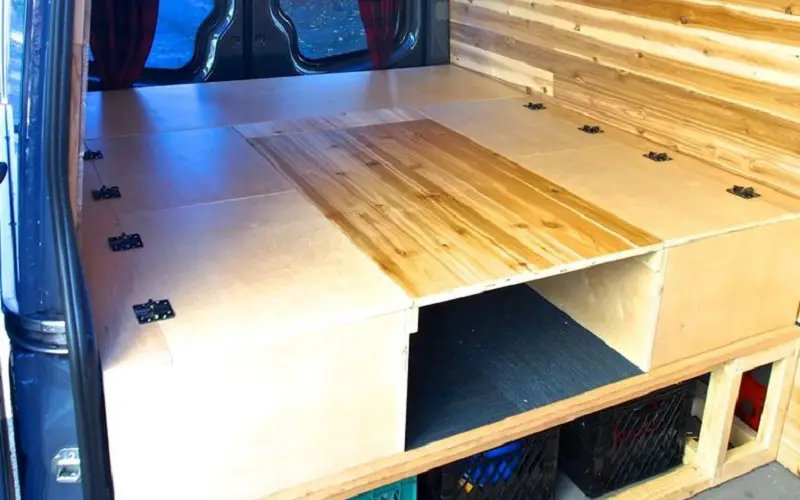
This is a pretty popular design, which is a good way to make the most of the available space in a van. This bed design type has a dual-purpose use, which functions as both a bench seat and a bed. Not only is this a space-efficient design, it is also a practical one.
By using the tabletop for the base for the bed, you are able to minimize the extra things you will need to convert your dinette into a sleeping space. There is also no need to find somewhere to store the table when the bed has been assembled.
This design creates a large, comfortable bed space. You can also factor in extra storage into the design by creating space under the bench seats.
You will, however, need to find the right mattress/couch pillows to use in order for this to work.
Pros:
- Space saving, as it merges a bed with a dinette
- Quick and easy to set up
Cons:
- Bed needs to be assembled each night
- Gaps between cushions can be uncomfortable
- Can’t have bed and table out at the same time
The Murphy Bed
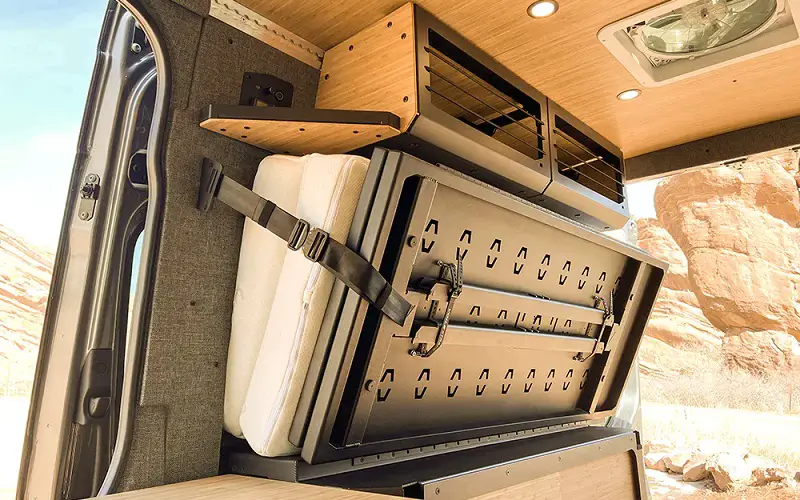
You’ve probably heard of the Murphy bed before, and it can be a great design to utilize in a campervan, as it will give you a lot of extra floor space for bikes, surfboards, and other equipment.
A Murphy bed is a bed that folds down from the wall, often from a cupboard. It is traditionally used in small apartments, but the design works well for space efficiency in camper vans. If it’s done well, the Murphy bed can be a stylish choice, as everything will be hidden away during the day.
Another great feature of the Murphy bed is that there is no need to put your bed together each day, as it will simply flip down. You can also use a full mattress, which means that you don’t have to worry about there being any uncomfortable gaps between cushions.
If you don’t need or don’t want that much floor space, you can also incorporate a bench into the design. The bench will be on the outside of the cabinet, and the bed will rest on it once it is pulled down. This means you can incorporate seating and sleeping space in one handy design.
If you want to use this design for a double bed, you will need a fairly wide campervan.
Pros:
- Space efficient
- No need to assemble bed each night
- Can function as a seating area to
Cons:
- Can be hard to construct
- Need a big van for a double bed
Bunk Beds
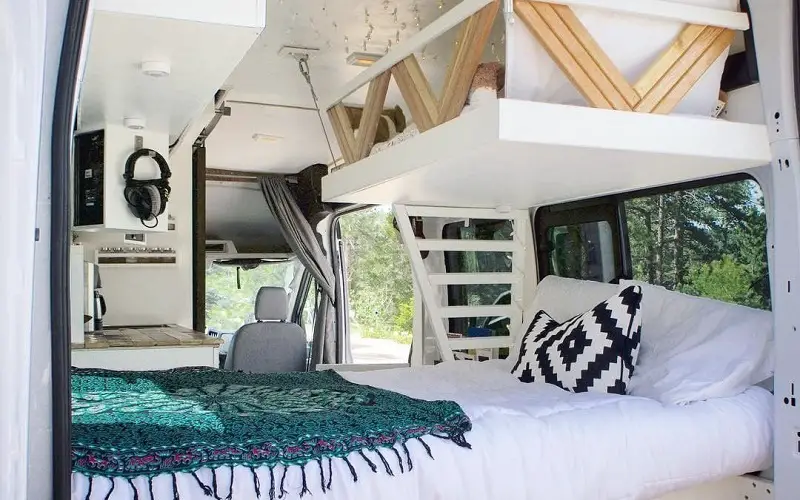
It can be difficult to squeeze more than two people into a small campervan, but by using a bunk bed design, it can be done well and look great! Bunk beds are an effective way to add an extra bed to a campervan, and is an excellent solution for campervan enthusiasts who have children.
You can either place a bunk bed on top of a platform bed, or you can stack two single beds on top of each other. As a bunk bed doesn’t take up any extra floor space, you have more room for other living spaces.
When installing a bunk bed, make sure there is enough headroom, and that it is securely attached to the van, as it needs to support someone’s body weight.
Pros:
- Space efficient
- Good for families, or more than two people
Cons:
- Less storage space
- Not cosy enough for a couple
Flip-out Bench
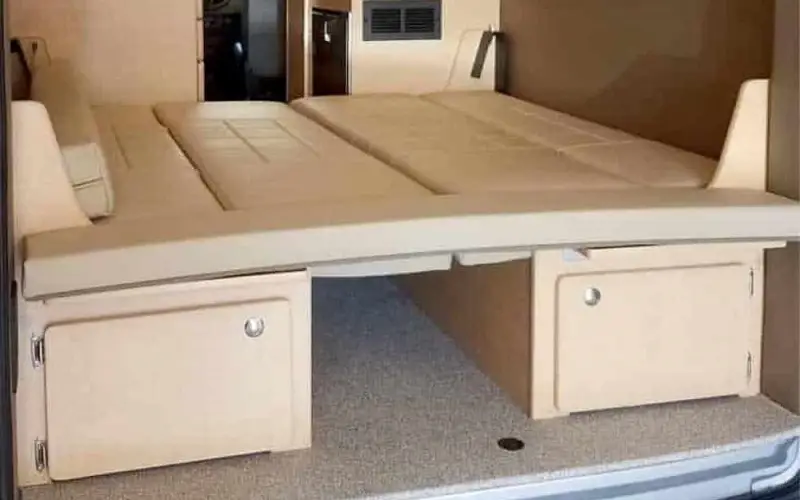
If you’re looking to maximize space efficiency, why not try a flip-out bench design? This is a folding wooden bench that doubles up as a bed.
The wooden bench is attached to a wooden platform that serves as a backrest. They are mounted together and attached with a hinge. The bench can be pulled down to form a flat surface which will rest on the legs of the bench. All that needs to be added is a mattress, and it’s good to go. When the bench is closed, it can be used as a couch.
You can easily use two sofa cushions, a futon, or a fold-out mattress to form the mattress, so there’s no need to worry about where to store one. You will however need to find somewhere to store bedding and extra pillows.
Pros:
- Space efficient
- Sleeping and sitting area in one
- Quick and easy to construct and set up
Cons:
- The bed needs to be made each night
- Not much storage space
- Need to find somewhere to store bedding and extra pillows
Couch Bed
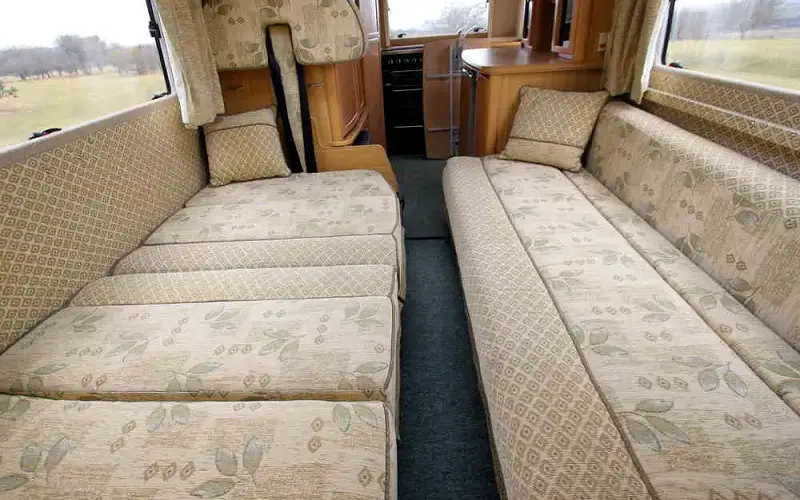
This is pretty similar to the flip-out bench design, however, there are a number of different ways a couch bed can be built. One of the most common designs is to use two couch benches facing each other. The benches fold down to hold the cushions in place when you’re ready for bed.
This is a simple, and effective design that gives you both a living and sleeping space. You can even add cupboards into the benches to give you more storage space – kind of like the storage space underneath platform beds.
Pros:
- Multipurpose space
- Easy to put together
Cons:
- Bed needs to be made each night
- Gaps between pillows can be uncomfortable
Slider Bed
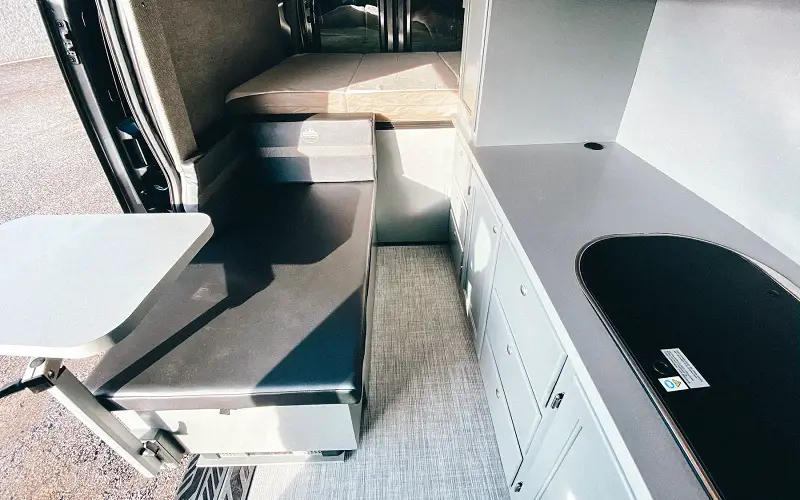
Another common technique is to use a slider bed. This is essentially a couch extension, which works by extending a couch using sliding slats. The couch can be mounted either against the side wall or at the rear of the van, depending on the dimensions of the van.
Simply move the slats into place when you want to put the bed together.
This is the perfect solution if you value space over a permanent bed setup. The sliding slats make it easy and quick to put the bed together. However, you will have to find somewhere to keep your mattress, bedding, and pillows. You can always utilize the couch cushions so that they double up as a mattress.
Just remember to install a lock for the slats, that way they can’t slide around when you’re driving.
Pros:
- Saves space by merging the bed and couch
- Quick and easy to set up
Cons:
- The bed needs to be made each night
- Need special couch pillows to double up as a mattress
Drawbridge-Style Bed
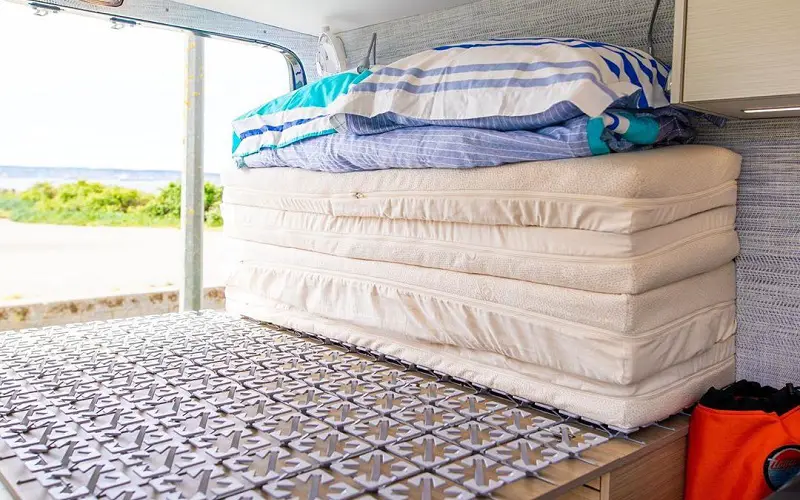
Drawbridge-style campervan beds work similarly to the Murphy bed designs, except that the mattress folds like an accordion, rather than lying flat. This design tends to take up a lot less room compared to a Murphy bed too, which is great if you need extra storage space.
For some people, they need to be able to store large items when in transit, like bikes, surfboards, and motorbikes. A drawbridge-style bed is the perfect option to allow you to do this.
As the bed is folded up during the day, it gives you more space to store gear and gives you more freedom to move around your van during the day. However, it is more inconvenient to put together and is often considered uncomfortable due to the gaps in the pillows.
Pros:
- Space saving for more storage options during transit
- Freedom to move around the van when the bed is put away
Cons:
- The bed needs to be assembled each night
- Inconvenient to assemble
Over Cab Bed
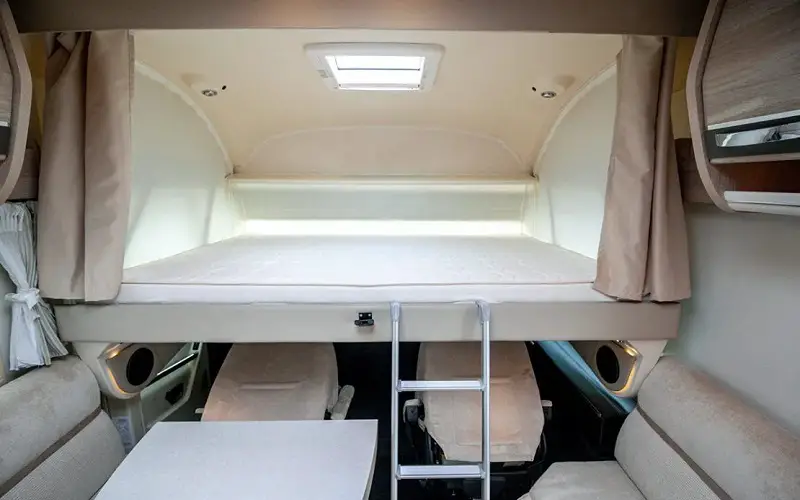
Some old-school motorhomes or larger vans tend to have some extra space over the driver’s cab. If you have a van like this, then this can be a great place for you to build your bed. It also serves as a static bed, which means that you do not need to assemble it every night, but it is also out of the way of the rest of the living space.
This will give you a greater floor space to work within the main area of your building. You can use it for seating, storage, or whatever else you like.
A downside to this bed design is that you may not have a huge amount of headroom, so it really depends on the style and size of your van.
Pros:
- Space efficient, giving you more space in the main living area
- Bed is permanently set up, so no need to assemble each night
Cons:
- May not have sufficient headspace
Folding Bench Seats
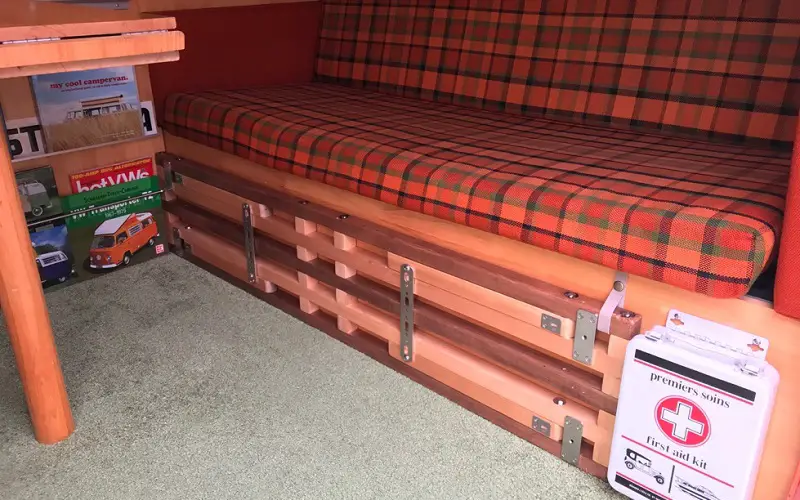
If you don’t fancy constructing your own bench bed, you can get specially made folding benches, like the Travois seat folding beds. These are pretty similar to the rock’n’roll campervan bed designs used in the classic VW bus.
They function like normal car back seats, but can quickly transform into a double bed. This bed style is perfect if you’re traveling in a compact camper van, and need a bed that can be extended lengthways.
It’s also good if you need some extra seat-belted seats for extra passengers. You can buy units that have been tested and highway-approved so that you can safely and legally drive passengers around.
Whilst these folding seats are practical they’re not the most comfortable of sleeping spaces and can take up some vital floor space.
Pros:
- Easy to set up
- Allows you to safely and legally have passengers on board, as the seats have seat belts
Cons:
- Need to be especially ordered
- Can be uncomfortable
- Takes up a lot of room and storage room
Drop-Down Bed System
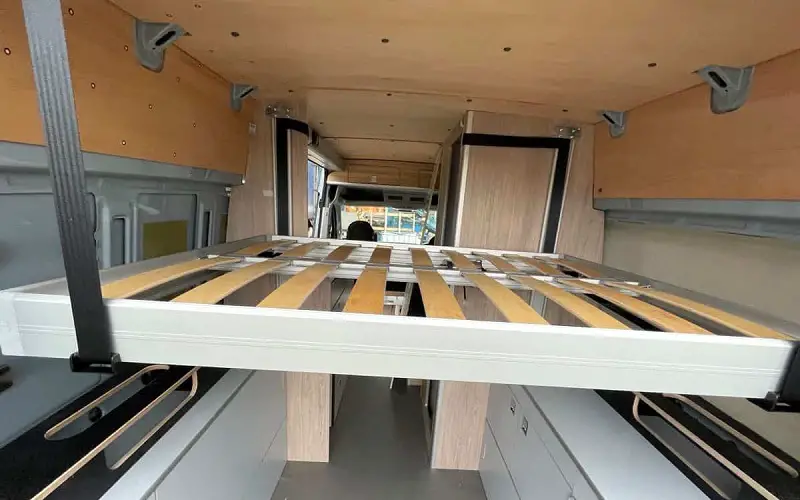
This is the mother of all campervan bed solutions. You’ve probably come across hundreds of YouTube videos where people have created their own custom drop-down bed system. It’s basically an electric bed that disappears into the ceiling with the touch of a button.
It’s considered a hybrid between a platform bed and a convertible bed, as it’s like having a fixed bed and seating area all at the same time. The great thing about this bed solution is that your bed is always ready to go, and can be put out of sight during the day when you want to relax or use a seating area. It also means that you have more storage and floor space underneath the bed.
Although this is a fantastic bed solution, it can be very expensive in comparison to the rest of the bed setups and solutions. It’s also pretty heavy, which means it will take up a considerable amount of your camper’s storage space. You might also not have the same ‘garage’ storage that a regular platform bed will provide you with, but this can be solved by adding storage under the bench seats that will sit below the bed.
Pros:
- Bed is permanently set up
- Keeps the bed out of sight during the day
- Room for entertaining and relaxing with a seating area
Cons:
- Is expensive and can be tricky to construct yourself
- Heavy, so will use up a lot of your van’s weight allowance
Things to Consider When Using Platform Beds
Headroom
One of the main concerns of using a fixed platform bed is making sure you consider head space/room, especially if you want to add storage space underneath the bed.
If you’re planning on building the bed quite high up, make sure you keep enough room above the bed. Not only will it prevent you from hitting your head, it will give you more room to get in and out.
Van Width/Length
A platform bed usually functions better in wide vans, as you can sleep across the van. However, with narrower vans, it means that you have to use a longer platform to provide a full-lying space, which means that it takes up more room.
However, there is a sort of fix you can use if you want to use the platform in a narrower van. You can use something called flares, which are fiberglass panels. They can widen the usable space in your van, which allows you to put a platform bed widthways, giving your extra room elsewhere in your van.
However, flares don’t come cheap, and will need to be installed by a professional. You also won’t be able to insulate your van where the flares have been installed.
If you have a narrower van, and don’t want to spend money on flares, but want to make sure you have plenty of extra room in your van, you might want to consider one of our other bed design suggestions.
Bonus Solutions
Here are a few quick and simple ways to get around installing a bed completely!
Skip the Bed
Not every van needs to be fully constructed, especially if construction is not your kind of thing. You can simply throw a mattress or ground pad down on the floor, and it can work just as well. Using less wood will also help you save on weight, which will make your gas last longer.
Pros:
- No construction needed
- Cheap
- Less wood means that you decrease your van’s overall weight
Cons:
- Can be uncomfortable if you’re frequently sleeping in your campervan
- Needs to be set up each night
- Might not have room depending on the furnishings of the rest of your fan
Hammock
When you have a small living situation, using a hammock can be a great sleeping solution. Simply string your hammock across the inside of your vehicle when you’re ready to sleep. This is a great solution if you’re a fan of hammock life.
Just make sure that whatever you’re attaching your hammock to is safely secured, otherwise the hammock might fall during the night and you may sustain an injury.
Pros:
- Little to no construction needed
- Inexpensive
- No compromise on floor space or storage
Cons:
- May be uncomfortable for some
- Not ideal for couples
- Bed is not fixed in place, so may move around at night
Things to Consider Before You Get Started
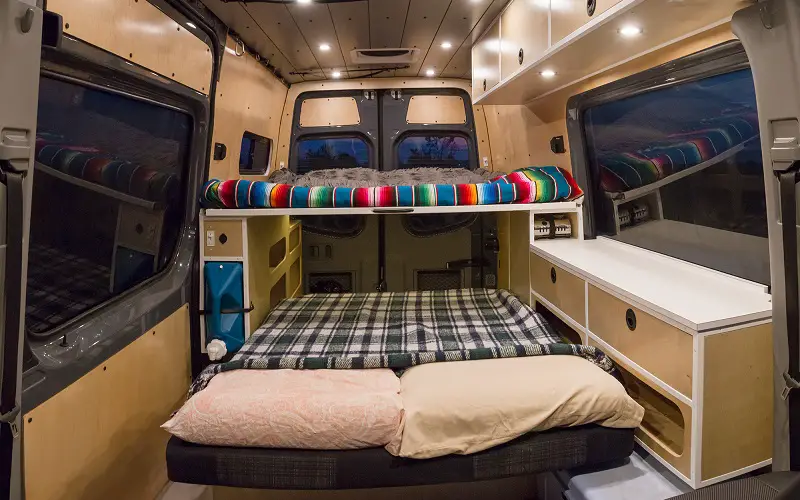
Before you begin your van conversion, there are a couple of different things you need to consider and plan.
Plan the Interior Layout With the Bed in Mind
Your bed will take up the most room in your campervan, so when you’re making the interior plan, you need to think about that first. Once you’ve found a position for your bed, it will give you an idea of how much living space you are left to work with.
Make Sure You Are Able to Fully Lie Down
After you’ve gone through all of the effort of converting your van, the last thing you want is to have an uncomfortable bed which you don’t fit into. Make sure you are able to fully stretch out in the space you want to use for your bed – be sure to make measurements.
Take a pillow and test out the space to make sure you have enough room. Don’t forget to take into consideration the insulation and sound-proofing, as this can take a couple of inches off of the walls.
Give Yourself Enough Head Space
Are you comfortable with sliding or crawling into your bed? Do you want to be able to sit up, or are you okay with only being able to lie down? These are the type of questions you need to ask yourself before constructing your bed.
Fixed Bed or Convertible Bed?
Think about how often you’ll be using your campervan, and what you’ll be using it for. Does it make sense for you to use a convertible bed design, which means that you’ll need to put your bed together each night? Or does it make more sense to have a fixed bed, like a platform, which means that it’ll always be ready for you?
Your Handiness Skills
If you’re converting your van on your own by only relying on your DIY skills, bear that in mind when thinking about what bed design you will use. Some campervan ideas are a lot more complicated to construct than others, like the Murphy bed, or the electronic platform bed. Be sure to check out the building plans before you commit to a design.
It’s also worth asking other campervan converters what design they opted for. Ask what they liked about the design they chose, how complicated it was to construct, and if there’s anything they’d change if they were to build it again.
Ask About Common Conversion Issues
The great thing about converting a van into a camper van is that there is a whole community of people who have a wealth of experience and knowledge, so there’s always someone you can ask. Ask around to see if anyone had any problems with their conversions, and if there’s anything that they would avoid.
Campervan Mattresses
Once you’ve chosen the best van design for you, you can start looking at mattresses. These will be important, as you want to make sure you can get a comfortable night’s sleep after you’ve gone through all of the effort to convert your van.
First, you’ll need to start by carefully measuring the bed space. If you’ve gone for a flip-out or slide design, you’ll need to measure for a folding mattress or for individual sofa cushions. Once you have your measurements, you can begin to choose the kind of mattress that you would like to use.
For fixed-platform beds, we recommend opting for a memory foam mattress, as this will provide you with the most comfort. Choose the size which best fits the shape of your van.
As we mentioned previously, for flip-out or slide designs, you’ll want to try a ready-made folding mattress, as these can also function as sofa cushions when your bed is stored away.
If you have a drop-down table bed, it’s best to opt for memory foam pieces. These can easily be cut to fit into the shape of your dinette. Once you’ve cut them to fit, you can upholster them with a nice fabric which will protect the mattress pieces, and give them a bespoke look.
When it comes to memory foam mattresses, we recommend trying gel-infused memory foam. Not only are they slim and breathable, they’re also easy to cut.
Final Thoughts
Choosing the right bed for your campervan can be a long and personal process. There are so many factors that you need to consider, including budget, needs, space, and how many people will be traveling in the van.
It’s important that you make the right decision, as a bed will take up the most room in the van, no matter what design you choose. If you don’t like what you pick, it can be tough and expensive to change, so it’s a decision that you can’t afford to rush.
Hopefully, the designs in this guide have given you some “buildsperation” and ideas to use in your own van. Whatever design you choose, just make sure it suits your needs and the size of your van.
Happy building!
References:


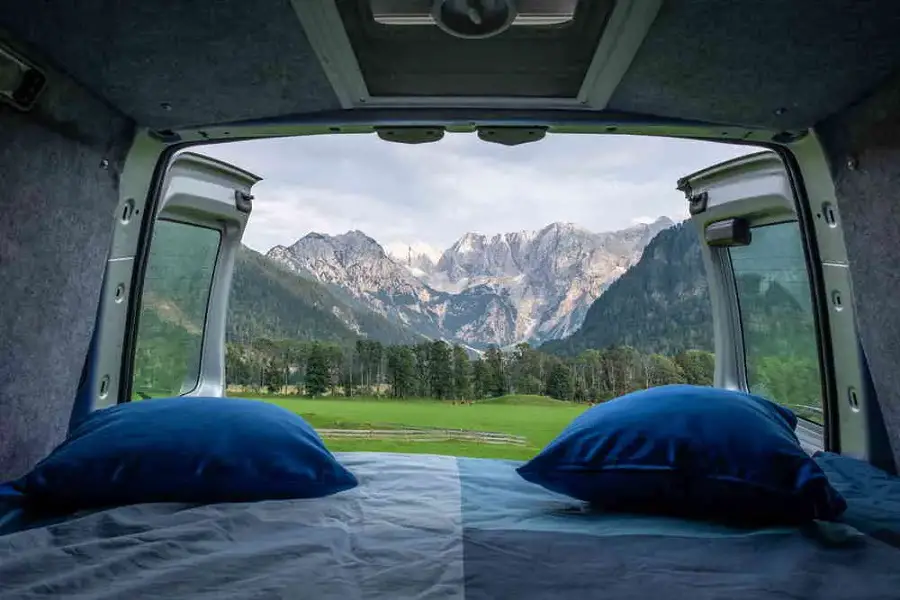

![9 Final Thoughts And Items For Your First Camper Adventure [Checklist] 17 RV Camping Checklist](https://kempoo.com/wp-content/uploads/2018/11/first-camper-adventure.jpg)
